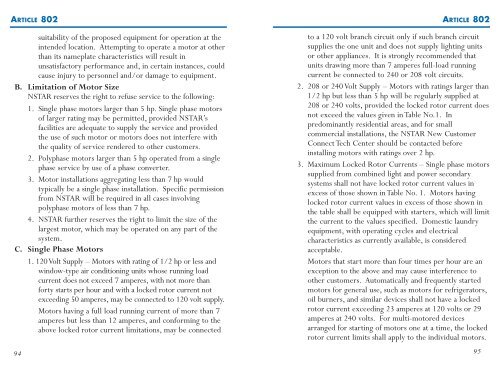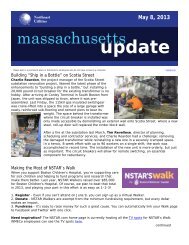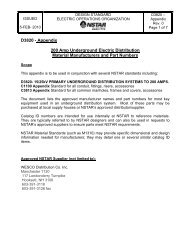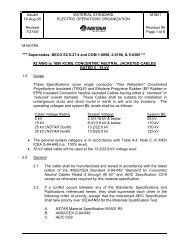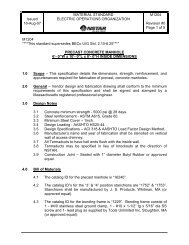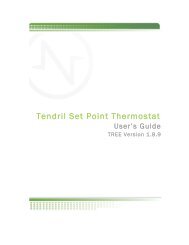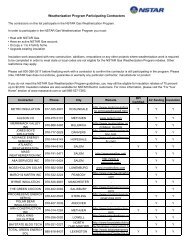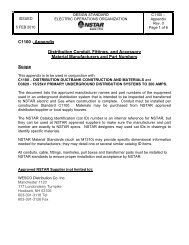INFORMATION & REQUIREMENTS ELECTRIC SERVICE - NStar
INFORMATION & REQUIREMENTS ELECTRIC SERVICE - NStar
INFORMATION & REQUIREMENTS ELECTRIC SERVICE - NStar
You also want an ePaper? Increase the reach of your titles
YUMPU automatically turns print PDFs into web optimized ePapers that Google loves.
ARTICLE 802<br />
suitability of the proposed equipment for operation at the<br />
intended location. Attempting to operate a motor at other<br />
than its nameplate characteristics will result in<br />
unsatisfactory performance and, in certain instances, could<br />
cause injury to personnel and/or damage to equipment.<br />
B. Limitation of Motor Size<br />
NSTAR reserves the right to refuse service to the following:<br />
1. Single phase motors larger than 5 hp. Single phase motors<br />
of larger rating may be permitted, provided NSTAR’s<br />
facilities are adequate to supply the service and provided<br />
the use of such motor or motors does not interfere with<br />
the quality of service rendered to other customers.<br />
2. Polyphase motors larger than 5 hp operated from a single<br />
phase service by use of a phase converter.<br />
3. Motor installations aggregating less than 7 hp would<br />
typically be a single phase installation. Specific permission<br />
from NSTAR will be required in all cases involving<br />
polyphase motors of less than 7 hp.<br />
4. NSTAR further reserves the right to limit the size of the<br />
largest motor, which may be operated on any part of the<br />
system.<br />
C. Single Phase Motors<br />
1. 120 Volt Supply – Motors with rating of 1/2 hp or less and<br />
window-type air conditioning units whose running load<br />
current does not exceed 7 amperes, with not more than<br />
forty starts per hour and with a locked rotor current not<br />
exceeding 50 amperes, may be connected to 120 volt supply.<br />
Motors having a full load running current of more than 7<br />
amperes but less than 12 amperes, and conforming to the<br />
above locked rotor current limitations, may be connected<br />
94<br />
ARTICLE 802<br />
to a 120 volt branch circuit only if such branch circuit<br />
supplies the one unit and does not supply lighting units<br />
or other appliances. It is strongly recommended that<br />
units drawing more than 7 amperes full-load running<br />
current be connected to 240 or 208 volt circuits.<br />
2. 208 or 240 Volt Supply – Motors with ratings larger than<br />
1/2 hp but less than 5 hp will be regularly supplied at<br />
208 or 240 volts, provided the locked rotor current does<br />
not exceed the values given in Table No.1. In<br />
predominantly residential areas, and for small<br />
commercial installations, the NSTAR New Customer<br />
Connect Tech Center should be contacted before<br />
installing motors with ratings over 2 hp.<br />
3. Maximum Locked Rotor Currents – Single phase motors<br />
supplied from combined light and power secondary<br />
systems shall not have locked rotor current values in<br />
excess of those shown in Table No. 1. Motors having<br />
locked rotor current values in excess of those shown in<br />
the table shall be equipped with starters, which will limit<br />
the current to the values specified. Domestic laundry<br />
equipment, with operating cycles and electrical<br />
characteristics as currently available, is considered<br />
acceptable.<br />
Motors that start more than four times per hour are an<br />
exception to the above and may cause interference to<br />
other customers. Automatically and frequently started<br />
motors for general use, such as motors for refrigerators,<br />
oil burners, and similar devices shall not have a locked<br />
rotor current exceeding 23 amperes at 120 volts or 29<br />
amperes at 240 volts. For multi-motored devices<br />
arranged for starting of motors one at a time, the locked<br />
rotor current limits shall apply to the individual motors.<br />
95


